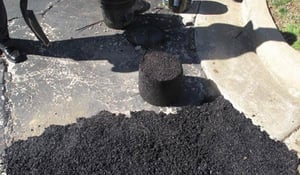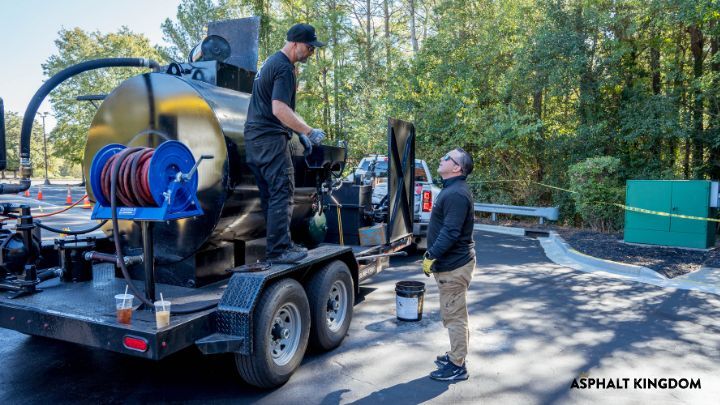Table of Contents
If you are undergoing a paving project that requires blacktop excavation, it's important to understand the specifics of how to cut asphalt. This guide will help you get started.
Blades for Cutting Pavement
One of the most important steps to take before cutting asphalt is making sure that you're using the right equipment. Contrary to common assumption, a jackhammer is not the best tool for this job. In fact, this could actually weaken the surrounding asphalt. Instead, use an asphalt cutting blade for the best results.
Cutting asphalt requires a unique blade that is different from one you would use to cut other surfaces such as concrete, marble, or granite. Because asphalt is softer, it requires a diamond blade with a hard bond. Other soft-bonded blades are not effective on asphalt pavement cutting.
FREE DOWNLOAD!

Get Work All Year Long:
Add Pothole Repair To Your Business
With a diamond asphalt cutting blade, the exposed edge is worn away as it cuts through the asphalt. Wear on the blade exposes a new layer of grit, resulting in sustained cutting.
Asphalt cutting blades come in both wet and dry varieties. Dry blades have a softer bond than wet asphalt cutting blades. Additionally, wet blades require water to cool and lubricate the cut while pavement cutting.
MINI INFRARED ASPHALT HEATER
- Reheats asphalt for easy repairs
- For asphalt seams, alligator cracks, & more
- One-person operation
When is it Necessary?
Cutting asphalt is always necessary for asphalt replacement and frequently required for asphalt repairs that involve cutting away deteriorating pieces of asphalt, such as filling potholes. If you need to know how to properly cut asphalt to complete a job, you'll need to have the appropriate pavement-cutting tool, as well as the materials and equipment to fill cracks and asphalt equipment for repairing potholes.
Steps on How To Cut Asphalt
Learning how to cut asphalt is just a matter of understanding the three basic steps. Whether you are fixing a pothole or removing a damaged section, the steps for cutting asphalt are as follows:
Step #1: Sweep
Sweep the area you will be working clear of all debris, so your saw doesn't catch on pebbles and rocks. Remember – safety first!
Step #2: Mark Your Cutting Lines
You will need to cut where the pavement is still in good shape. In other words, don't just cut out the damaged area — widen your cutting zone a bit so you've got good solid edges. You'll also want to square up edges, as this makes for a better and longer-lasting repair than a round patch. Once you've decided where and how to cut the asphalt, mark with a chalk line, and then dent the chalk line with an old screwdriver and a hammer to give the blade a path when you are cutting asphalt.
Step #3: Make The Cuts
Set your blade depth to the thickness of the paving (you can check this by digging at the edge of the pavement to see how deep it is). Make your first straight cut, stop, and lift the blade to the next position for your next straight cut. Knowing how to cut asphalt means you know never to turn the saw while the blade is running, or you'll break the blade.
Now you're all set to remove the damaged section and patch.
Cable Tip: If you're just cutting to run a cable, one straight cut path is all you need. Mark, cut, lay the cable, and crack fill.
Repairing Potholes

Pothole patching and knowing how to cut asphalt are key to saving your pavement. One of the most common reasons for asphalt excavation is to repair a pothole. Though it might seem intimidating, it's actually fairly simple.
Once the area has been properly swept, marked, and cut following the steps above, the area that will be patched will need to be cleaned of debris. If the area is wet, it should be blotted dry before patching. Next, begin filling the hole with asphalt material, placing the mix against the edges first. Finally, level and spread the mix with an aluminum paving rake. Do not over-rake, though, or it can lead to coarse material rising to the surface.
If you are an asphalt repair contractor or you're responsible for large expanses of asphalt, you may want to consider an asphalt hot box that can hold hot asphalt for patchwork for up to 14 hours. This versatile asphalt box can be used all year round, even in the winter, to heat asphalt for patching.
While it's important to know how to cut through asphalt, it's just as important to learn the techniques to properly maintain and repair remaining asphalt to prevent damage and decay that ultimately results in the need for asphalt replacement.
Our free Property Owners Asphalt Maintenance Course will show you how to professionally maintain your pavement.
Proper Asphalt Maintenance
Asphalt pavement is relatively easy to keep in good condition for many years without the need for cutting asphalt. By simply filling surface cracks as they appear and sealcoating every two to three years, you can prevent the damage that would deteriorate your asphalt to the point that removing the blacktop and replacing it becomes necessary.
Fixing Cracks
Unrepaired cracks are a leading cause of blacktop excavation. Cracks, as a result of issues such as poor foundation, often require asphalt replacement, unfortunately. Cracks due to issues such as earth movement, heavy traffic, tree roots, and weather, on the other hand, are more common and can be repaired with the right crack fillers to prevent them from growing.
At Asphalt Kingdom, we recommend the use of Elasta-Fill Cold Pour Asphalt Crack Filler because of its durability and ability to dry quickly. Once you've cleaned cracks of debris and vegetation, the easy-to-use filler can be poured directly into fissures.
Sealcoating
By applying a sealcoat to your asphalt every two to three years, you can minimize the necessity for blacktop excavation and replacement. We highly recommend the use of asphalt emulsion sealer because of its unique asphalt rejuvenation capabilities. This professional-grade sealer is also environmentally friendly and prevents water and other liquids from deteriorating the surface of your blacktop pavement.
Asphalt Experts
At Asphalt Kingdom, we specialize in both crack repair and sealcoat equipment and supplies and provide quick shipping directly to your home or place of business. Need to learn more about how to cut asphalt or how to properly maintain your asphalt? Give us a call at 1-866-399-5562. We'll be more than happy to answer all of your questions and provide you with expert tips on how to best care for your asphalt.

.png?width=228&height=228&name=Mini%20Heater%20(1).png)







-2.jpg)
-1.jpg)